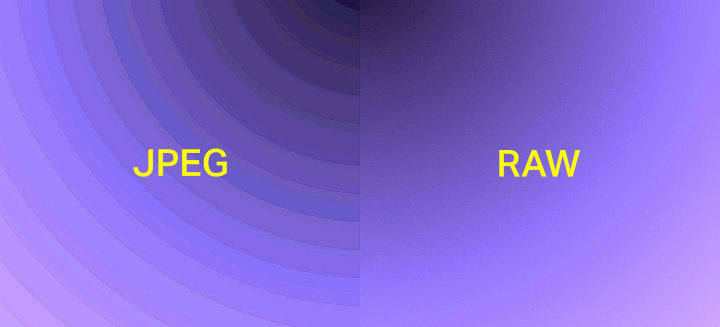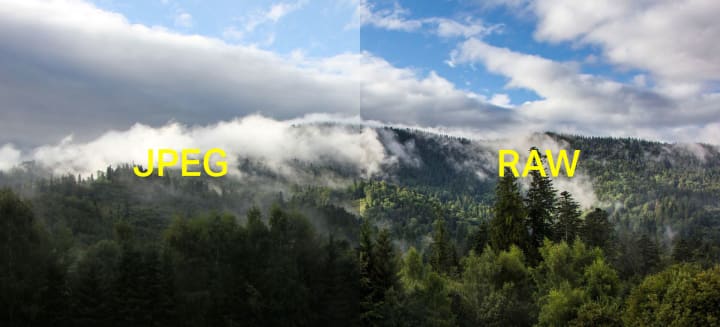Why You Should Shoot in Raw Instead of JPEG
No, really, you need to shoot in raw—and if you aren't, you're making a fool of yourself.

Back when I was a beginner model, I didn't really know that there were too many other photography formats other than JPEG and GIF. I mean, that's all you ever really see on the internet, right? Well, yes—but then I actually started learning industry stuff from photographers, too.
I then learned about raw images. Raw images are, for lack of a better term, uncompressed images that are directly recorded from your camera's DSLR imager. These images are (and always will be) much larger than a typical JPEG.
Websites typically won't accept raw image uploads because they take up too much space. This means that models typically will hate raw images because they can't use them.
One of the photography lessons I learned from the pros is that photographers really need to shoot in raw, rather than JPEG. At first, this baffled me because models often need JPEGs way more than a raw image.
Then, once I heard the reasons why, it all made sense...
You need a high quality image to make a high quality edit.
One of the biggest reasons why every photographer should shoot in raw is the quality of the photo. Raw images show every little detail before it's compressed, and that means volumes as far as Photoshop goes.
A higher quality image lets you see flaws better, fix them with a better level of detail, and also do so with a more natural finish. If you want a better finished product, raw image captures are definitely the best way to go.
Issues like banding can be smoothed out easily in raw formatting.

Ever wonder why professional photos look so crisp? It's the fact that they shoot in raw. When you shoot raw, otherwise untouchable issues like color banding, overshadowing, or heavy (unwanted) blur quickly become easily recoverable.
If you were to shoot the same photo in a JPEG file format, there would be no way to recover those shots. The reason why is because the computer already compressed the image too far to actually be edited that heavily without issues.
Not all the Photoshop hacks in the world can save a JPEG from some of these matters.
Destruction-free adjustments are the name of the game with raw files.
When you're altering a raw file, you're not actually changing the original data. Rather, what you're doing is saving a set of instructions on how the JPEG you're going to make out of the raw file will need to be made.
What does this mean for your photos? Even if you're not a beginner photographer looking for tips, let me count a couple of things:
- There will be no yelling of, "Crap, I can't believe I made that mistake! My original is ruined!"
- You have no chance of accidentally saving a botched version of your image over the original version.
- You will never be unable to go back and make changes.
- If you're a newbie, you can try out different editing tips for beginners without having to worry that you'll wreck an image.
When you shoot in raw, you get a lot more options. JPEGs are a very "loss-prone" format because you end up losing quality every time you go in and make more alterations to the photo.
You get brighter, more true-to-life photos with raw images.

One of the reasons why JPEGs always seem kind of faded is because part of their compression algorithms reduce the full spectrum of color you get in a photo. JPEGs only will get around 256 different levels of brightness—and that hasn't changed since the 90s.
Meanwhile, when you shoot in raw, you get over 16,000 different colors. This makes for a smoother transition, which in turn means a better, more "lively" image.
Raw images make overexposed and underexposed images a thing of the past.
Ever wonder how professional photographers get such great shots of nightclubs, even though it's the dead of night? Well, part of it is lighting. I can't deny that. The other part, though, is that they choose to shoot in raw then increase the light in post-processing.
Simply put, raw images are the ones that allow you to salvage overexposed photos and underexposed images seamlessly. Trying that with a JPEG will often ends up with heavy shadows and oddly "melted-looking" pictures.
White balance adjustment is also better in a raw image.
White balance is crucial to getting a shot that "pops" the right way. JPEG formatting tends to throw white balance off-kilter, and if you're trying to adjust it, can end up causing a lot of quality loss.
Raw images are easier to adjust when it comes to white balance, and that tends to mean a lot better pictures with a lot less noise.
JPEGs are an automated form of refinement, alteration, and compression. This means that you're automatically ceding a lot of control to the camera when it comes to things like sharpening, contrast, and even focus.
When you shoot in raw format, you allow yourself to be in total control. Want a sharper pic? Get it done in Photoshop, with a high-grade sharpening algorithm. Want to get rid of the weird balance? Photoshop it.
Raw means creative control, period!
Raw pictures also tend to mean better prints.
Most people grossly underestimate how much detail printing can bring out—and how grainy JPEGs can be. Since raw images offer higher detail quality, they tend to be better when you're trying to create high-definition prints.
Raw image files have better color quality, an overall higher image quality, and bring out details beautifully. That's why those who shoot in JPEG will do so at their own risk, especially if they're trying to make a large poster print of their subject.
Overall, it's just more efficient to shoot in raw in most situations.
Raw gives you more control, way more ease when it comes to editing your goods, and avoids mistakes with post-processing. JPEG tends to mean a quicker shot, but at the same time, will often mean a living hell when it comes to actually editing your shots to perfection.
Basically, if you want your stuff to look good, leave JPEGs to the selfies you take on Instagram.
That being said, there are some times when shooting in JPEG is better than shooting in raw.
Raw photos tend to make some cameras lag when it comes to buffering after each shot. If you're looking for a format that may allow for better rapid-fire shoots with loads of shots, you might want to reconsider the option to shoot in raw.
Simply put, JPEGs are ideal for time and memory conservation, but it does come at a cost. The question you need to answer is whether the quality is worth the time you put in.
About the Creator
Iggy Paulsen
Iggy Paulsen is a fan of anything and everything wholesome. He loves his two dogs, hiking in the woods, traveling to Aruba, building DIY projects that better humanity, and listening to motivational speakers. He hopes to eventually become a motivational speaker himself.







Comments
There are no comments for this story
Be the first to respond and start the conversation.